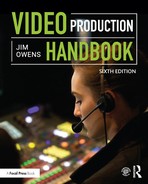CHAPTER 2
Production Crew
I’ve always maintained that, with the right crew, you can make a toenail-clipping competition riveting television. With the wrong crew, you can make an international soccer championship boring.
David Hill, CEO of Fox Sports Television
People are much more important than the coolest gear. The bottom line is that crew members who know what they are doing can make an incredible program with mediocre equipment. However, crew members who do not know what they are doing can make a mediocre program with the latest professional equipment. Because of the importance of people within a production, we are putting this chapter near the beginning of the book.
2.1 PRODUCTION CREW SIZE
Production crews come in all sizes. The crew for a documentary may consist of one person with a palm-sized camera. Many television stations have moved to one-person crews to reduce costs (see Figure 2.1). Other types of programming, such as a network dramatic production, may require a large number of people. It all comes down to what you are trying to accomplish.

FIGURE 2.1
Many television stations, due to
tight budgets, have moved to one-person news crews. In this photo, the reporter not only asks the questions and holds the microphone, but is also holding the camera on her shoulder.
VIDEO PRODUCTION CREW JOB DESCRIPTIONS
Most job descriptions for the crew have some commonalities from company to company and even country to country. However, you will find that the actual duties may fluctuate based on the company, production style, and the talents of the individual crew members. In this chapter we describe some of the basic positions that may exist on a video production. Because this book focuses on smaller productions, we will limit the list to the most common positions.
2.2 PRODUCER
The producer is generally responsible for a specific production. Usually the producer is concerned with the business organization, budget, the choice of the staff and the crew; script acceptance; production coordination; production scheduling. The producer may select or initiate the program concepts and work with writers. He or she may assign the production’s director and is responsible for meeting deadlines, production planning, locations, rehearsals, production treatment, approving program format, and other duties (see Figure 2.2).
2.3 ASSISTANT PRODUCER OR ASSOCIATE PRODUCER
The assistant or associate producer (AP) is responsible for assisting the producer. These responsibilities, as assigned by the producer, may include coordinating appointments and production schedules, making sure contracts are completed, booking guests, creating packages, and supervising postproduction.

FIGURE 2.2
A producer and director discuss the production plan with the crew.
2.4 DIRECTOR
While various people can influence the production, the director is the individual responsible for creatively visualizing the script or event. This means that the director instructs the camera operators on the type of shots wanted and then selects the appropriate camera shots for the final production. The director is also responsible for running the talent through their lines and movements based on the script. Directors need to be able to effectively communicate their vision to the crew. They need to be team builders who can move the crew toward their vision. This involves advising, guiding, and coordinating the various members on the production team (scenic, lighting, sound, cameras, costume, etc.) and approving their anticipated treatment. The director may choose and hire performers/talent/actors (casting), envision and plan the camera treatment (shots and camera movements) and editing, and direct/rehearse the performers during prerehearsals (Figure 2.3). He or she also evaluates the crew’s contributions (sets, camera work, lighting, sound, makeup, costume, graphics, etc.).
2.5 ASSISTANT DIRECTOR OR ASSOCIATE DIRECTOR
The assistant director (AD) is responsible for supporting the director in a wide variety of ways depending on the type of production. This may include shielding the director from interruptions, taking notes, reviewing storyboards, implementing shooting schedules, supervising prerehearsals, organizing locations and postproduction. For multicamera shoots, the AD may also be responsible for timing, lining up shots, graphics, and preproduced video segments while the director guides the actual performance and cameras. This person may be assigned some of the same responsibilities of an associate producer.
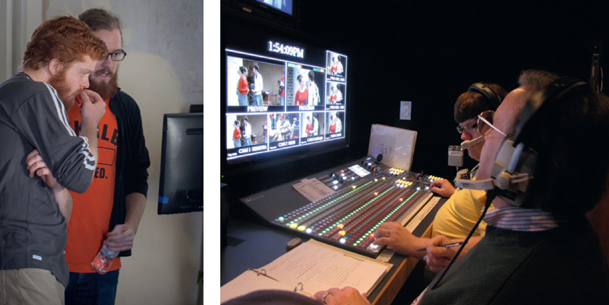
FIGURE 2.3
A field director (left) may review the camera shot on a monitor. A multicamera live production director (right) looks at multiple camera images and selects the most appropriate shot.
2.6 PRODUCTION ASSISTANT
The production assistant (PA) assists the director or producer with production needs. These may include supervising the production office (making copies, making coffee, and running errands) and location organization. Responsibilities may also include logging video recordings and taking notes during production meetings. During rehearsals and recording, this person may assist the producer/director with graphics or serve as a floor manager (FM).
2.7 FLOOR MANAGER OR STAGE MANAGER
The FM is the director’s primary representative and contact when the director is not on the set or in the studio. He or she may be used to cue talent and direct the floor crew. During the shoot, the FM is responsible for general organization, safety, discipline (e.g. managing noise), and security on the set. At times, the FM may be used to ensure that the talent is present. This job may be merged with the assistant director (Figure 2.4).
2.8 TECHNICAL DIRECTOR OR VISION MIXER
The technical director (TD) generally sits next to the director in the control room and is responsible for operating the television production switcher (and perhaps electronic effects). The TD may also serve as the crew chief. This person reports to the director (Figure 2.5).
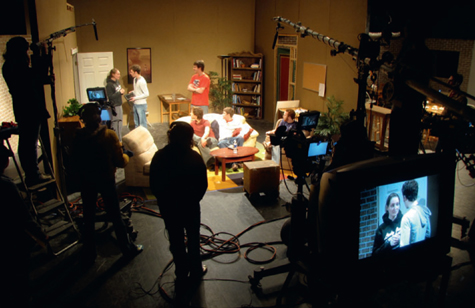
FIGURE 2.4
The stage manager represents the director on the set or in the studio. Here, silhouetted in the center, she is giving the actors instructions from the director on the set of a sitcom.
(Photo by Tyler Hoff)

FIGURE 2.5
Technical directors “edit” a live program by utilizing a production switcher and multiple cameras.
2.9 MAKEUP ARTIST
The makeup artist designs, prepares, and applies makeup to the talent, aided by makeup assistants and hair stylists (Figure 2.6).

FIGURE 2.6
A makeup artist prepares talent for a production.
2.10 GRAPHIC DESIGNER/OPERATOR
The graphic designer/operator is responsible for designing and implementing the graphics for the production. This individual is responsible for organizing and typing on-screen text and titles for a production, either to be used during the production or stored for later use (Figure 2.7).

FIGURE 2.7
Graphic designer/operators design, organize, and edit graphics for video productions.

FIGURE 2.8
The lighting director can make the difference between an amateur and a professional production.
(Photo by Will Adams)
2.11 LIGHTING DIRECTOR/VISION SUPERVISOR
The lighting director is responsible for designing, arranging, and controlling all lighting treatment, both technically and artistically. This responsibility may include indoor or outdoor lighting situations. The lighting director supervises the electricians, or gaffers, who rig and set the lighting equipment (Figure 2.8).
2.12 VIDEOGRAPHER/CAMERA OPERATOR/ PHOTOGRAPHER
The camera operators are responsible for setting up their cameras (unless the cameras have already been set up, such as in a studio situation) and then operating the cameras to capture the video images as requested by the director (Figure 2.9). On small productions, the videographer may have a lot of creative control over the image. In a multicamera production, the director usually makes most of the final creative decisions about the shot. In a dramatic production, the camera videographer may be called a cinematographer.
2.13 CAMERA ASSISTANT
The camera assistant is responsible for helping the camera operator set up the camera, making sure that the camera operator is safe (by keeping the person from tripping over something or falling), keeping people from walking in front of the camera when it is on, keeping the camera cable from getting tangled or tripping others, and guiding the camera operator during moving shots. A camera assistant may also work as a grip and push a camera dolly if needed (Figure 2.10).

FIGURE 2.9
Camera operators use a variety of cameras including studio, handheld, and DSLRs.
(Photos by Katie Oostman and SVG)

FIGURE 2.10
This camera assistant is making sure that the camera cables do not get tangled.
2.14 AUDIO MIXER/SOUND MIXER/SOUND SUPERVISOR
The audio mixer is responsible for the sound balance as well as the technical and artistic quality of the program sound. This includes determining the number and placement of the microphones required for the production. He or she also makes sure that the audio cables are properly plugged into the audio mixer and is responsible for the final mix (audio levels, balance, and tonal quality) of the production. The audio mixer supervises all personnel operating microphones and audio equipment (Figure 2.11).

FIGURE 2.11
The field audio mixer is using a small portable mixer to adjust the levels on the talent’s mic. Studio or remote production truck audio mixers use a larger mixer.
2.15 BOOM OPERATOR OR AUDIO ASSISTANT
Supervised by the audio mixer, the boom operator is responsible for positioning the microphones, running audio cables, operating the sound boom, troubleshooting audio problems, and operating field audio equipment (Figure 2.12).
2.16 ENGINEER
Engineers are responsible for setting up, adjusting for optimal performance, main taining, and troubleshooting all equipment used in a production.
2.17 WRITER
The writer is responsible for writing the script. Occasionally the producer or director will write material. At times, writers are assisted by a researcher who obtains data, information, and references for the production writer. In rare situations, such as episodic television production, the lead writer is over the director in order to maintain the story throughout the series.
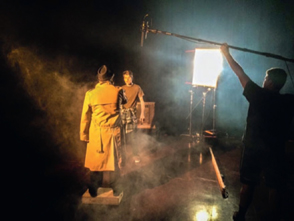
FIGURE 2.12
Boom operators are often called audio assistants.
(Photo by Tyler Horn)
2.18 EDITOR
The editor selects, compiles, and cuts video and audio to produce programs. He or she may assemble clips into segments and segments into programs, or this person may simply correct mistakes that occurred during the production process (Figure 2.13).
2.19 SET DESIGNER
The set designer is responsible for conceiving, designing, and organizing the scenic treatment for a production (perhaps even the graphics). He or she supervises the scenic crew in erecting and dressing the sets (Figure 2.14).

FIGURE 2.13
The editor selects, compiles, and cuts the video and audio together in order to create television programs.

FIGURE 2.14
Set designer.
PROFESSIONAL CREW
2.20 FREELANCE CREW
Many companies today have moved from a full-time professional production staff to utilizing a freelance crew. Freelancers are independent contractors who work for multiple organizations, hiring out their production skills on an as-needed basis. There are freelancers available who can fill every one of the production positions. Freelancers are generally paid on an hourly or day rate basis. If they have traveled far from their home base, freelancers usually get lodging and a per diem added to their contract. The per diem is a stipend that covers incidental costs such as laundry and meals.
2.21 BELOW-THE-LINE/ABOVE-THE-LINE
You may hear the terms “below-the-line” and “above-the-line” personnel. Although these terms may have different meanings to different companies, overall they are budgeting terms. Here are some common descriptions:
Above-the-line personnel usually refers to people who may have a fixed salary but who also will share in any profits the project generates. They are generally thought of as more artistic in nature. These positions would include producers, directors, actors, writers, and possibly graphic artists and designers.
Below-the-line personnel refers to everyone who is paid a wage and will not share in the profits. It generally refers to camera operators, editors, engineers, production designers, costume designers, and makeup artists. Below-the-line personnel may be eligible for overtime pay.
2.22 THE STRUCTURE OF A VIDEO PRODUCTION CREW
The structure of a production crew differs greatly from company to company. Even different types of productions, such as dramatic and sports productions, require different styles of hierarchy. Figures 2.15 and 2.16 show common general structures for single-camera and multicamera crews.
2.23 WHAT DO YOU WEAR?
What crew members wear differs depending on your job, who will see you, if you are indoors or out, and the event.
If you are in the studio, the public generally does not see the crew. The most common clothes are as casual as jeans. However, studios can often be cold, which means it is good to have a couple of layers so that clothing can be removed or added, depending on the temperature. Set-up days are always casual. Some inside events, such as a major awards ceremony, may dictate that the crew seen by the public actually dress well in order to fit into the overall environment during the shooting.
Outdoor work is much more unpredictable. In the morning it may be sunny, and by afternoon it may be pouring rain and cold. That means that multiple layers and types of clothing should be carried. Depending on where you are, that may include a T-shirt and jeans if it is hot, a long-sleeve shirt and hat to protect you against the sun, and a warm jacket to project you from the cold.
Whatever the situation, it is always important to look professional. You will get more respect from others, which will help you get your job done.

FIGURE 2.15
The single-camera crew.

FIGURE 2.16
A fairly common multicamera television production crew organization.
2.24 WHAT DO YOU BRING WITH YOU?
Bringing the right supplies with you can make all the difference in the world on a shoot. Again, it depends on where you are. It is always important to have something to write with and some paper. Here are some of the other things that should be considered:
■ hat
■ sunblock
■ bug spray
■ sunglasses
■ snacks
■ multitool (see Figure 2.17)
■ simple first-aid supplies
■ small flashlight.
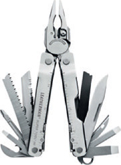
FIGURE 2.17
A variety of multitools are available.
(Photo courtesy of Leatherman)
Tommy Mitchell
What do you look for in a person when hiring?
Based on the needs of my show, experience would be the number one thing I look for before hiring. We keep detailed past histories of performance for every show that someone works for us and have a pretty extensive database of names. I generally am reluctant to hire someone who hasn’t worked for us in the past unless I get a reference from someone I particularly trust.
After experience, I’m looking for reliability and versatility. I like versatility because it provides a lot of flexibility to the director or producer. A solid camera operator who’s comfortable on hard camera and handheld is more valuable to me that someone who does only hard camera. Someone who is a video recorder/playback operator and who could do some editing if needed has a skill set that can make the show better.
How important is attitude when hiring?
Attitude is paramount when hiring. The freelance community is littered with fantastically talented ops that can’t get big shows because their attitude holds them back. We deal with it all the time with those who are unhappy that we booked them on Delta when United is their preferred airline, or that we don’t pay as much as someone else does. As crewers, we deal with so many events per day that we just don’t have time for the whiners and complainers, and pretty soon, their phones stop ringing. If there’s one thing I can say to a freelancer, it’s “No matter how good you are and how much you think you are needed for a show, I can replace you in a heartbeat.”

FIGURE 2.18
Tommy Mitchell, Crewer.
How important is networking?
It is all still about who you know. Most producers and directors have their favorite operators and look to take them to all their shows. You can certainly make a good living as a “gun for hire,” but becoming a “core” member of a crew requires some networking. In this business, your reputation certainly precedes you, so knowing the right people will keep you busy throughout the year.
Tommy Mitchell is responsible for hiring freelance crews for ESPN productions.
